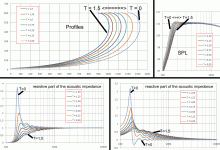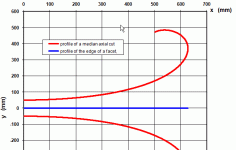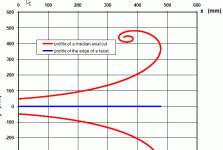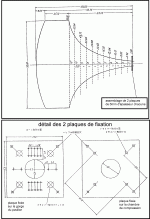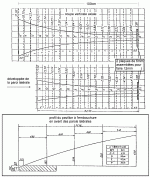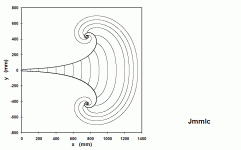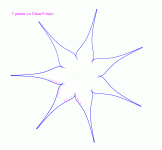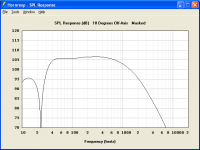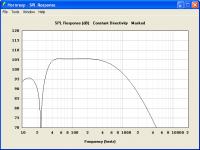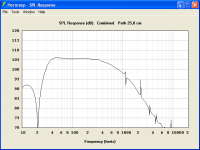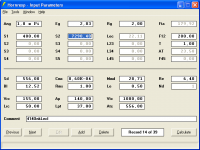Guys ... I'm Dancing as Fast as I Can (i.e, reading thread) but did not find if the throat angle of the horn design was full or half. My JBL 2420 is 9.2 deg total and I have to go to an Exp horn (T=1) to get the angle even close. A ref to post would be nice, too. I'm sure it was covered.
While here, do I still use the design Fc to be 1 octave below the desired crossover point?
Thanks, Zene
While here, do I still use the design Fc to be 1 octave below the desired crossover point?
Thanks, Zene
Jean-Michel, would you please explain or point me where I can read more about the T value and how the T value alters the horn (i know it alter the length, thats all).
If a t value of 0, (slightly longer horn) is suited to a particular range of horn etc woud be useful to learn.
If a t value of 0, (slightly longer horn) is suited to a particular range of horn etc woud be useful to learn.
Hello 3GGG,
T is a parameter in the formula giving the area versus the distance to throat of the large family called "hyperbolic horns". For a given cut-off frequency the T parameter acts on the shape of the horn and its length while the mouth area will keep the same.
For T = 1 the horn is called exponential.
For T between 0.5 and 0.707 the horn is called hypex.
For T = 0 the horn is called catenoidal.
For large T value over 1 the horn acts more as a waveguide
For very large T value over 1 the horn tend to be conical.
A T value of 0 has some advantages for bass horns and low-mid bass horn. The cut-off frequency becomes smaller (You can gain half an octave or so), but more interesting IMHO is the fact that above the cut-off frequency the reactance (the reactive part of the acoustic impedance) is nearly 0, so the phase distortion (in fact: the group delay distortion) becomes very low. (but better to use an electronic crossover having a very high slope... to benefit of that)
You can see on the attached graph the effect of the variation of the T parameter on a Le Cléac'h horn (Fc = 160Hz).
Best regards from Paris, France
Jean-Michel Le Cléac'h
T is a parameter in the formula giving the area versus the distance to throat of the large family called "hyperbolic horns". For a given cut-off frequency the T parameter acts on the shape of the horn and its length while the mouth area will keep the same.
For T = 1 the horn is called exponential.
For T between 0.5 and 0.707 the horn is called hypex.
For T = 0 the horn is called catenoidal.
For large T value over 1 the horn acts more as a waveguide
For very large T value over 1 the horn tend to be conical.
A T value of 0 has some advantages for bass horns and low-mid bass horn. The cut-off frequency becomes smaller (You can gain half an octave or so), but more interesting IMHO is the fact that above the cut-off frequency the reactance (the reactive part of the acoustic impedance) is nearly 0, so the phase distortion (in fact: the group delay distortion) becomes very low. (but better to use an electronic crossover having a very high slope... to benefit of that)
You can see on the attached graph the effect of the variation of the T parameter on a Le Cléac'h horn (Fc = 160Hz).
Best regards from Paris, France
Jean-Michel Le Cléac'h
Jean-Michel, would you please explain or point me where I can read more about the T value and how the T value alters the horn (i know it alter the length, thats all).
If a t value of 0, (slightly longer horn) is suited to a particular range of horn etc woud be useful to learn.
Attachments
Hello,
The popular version of my spreadsheet doesn't take in account a progressive adaptation of the horn to the angle exit of the compression driver. (I have another spreadsheet for that but less easy to use, so it is not public ).
What I recommand to you is to draw the exit angle of the compression driver at the throat of the profile of the horn and to use some spline curve in order to have a smooth transition on 10 centimeters or so. You can do it by hand also.
Best regards from Paris, France
Jean-Michel Le Cléac'h
The popular version of my spreadsheet doesn't take in account a progressive adaptation of the horn to the angle exit of the compression driver. (I have another spreadsheet for that but less easy to use, so it is not public ).
What I recommand to you is to draw the exit angle of the compression driver at the throat of the profile of the horn and to use some spline curve in order to have a smooth transition on 10 centimeters or so. You can do it by hand also.
Best regards from Paris, France
Jean-Michel Le Cléac'h
Guys ... I'm Dancing as Fast as I Can (i.e, reading thread) but did not find if the throat angle of the horn design was full or half. My JBL 2420 is 9.2 deg total and I have to go to an Exp horn (T=1) to get the angle even close. A ref to post would be nice, too. I'm sure it was covered.
While here, do I still use the design Fc to be 1 octave below the desired crossover point?
Thanks, Zene
Hello,
The popular version of my spreadsheet doesn't take in account a progressive adaptation of the horn to the angle exit of the compression driver. (I have another spreadsheet for that but less easy to use, so it is not public ).
What I recommand to you is to draw the exit angle of the compression driver at the throat of the profile of the horn and to use some spline curve in order to have a smooth transition on 10 centimeters or so. You can do it by hand also.
Best regards from Paris, France
Jean-Michel Le Cléac'h
Hello Jean Michel,
could you please explain how to build a Guigue's horn. It's quite based on IWATA's horn but flanges are shorter.
Thank you for your help.
PM
Hello,
Guigue used to start form the shematics of a low-mid Iwata horn published in the japanese magazine MJ.
To provide a WAS ("wife accepted size") this low mid horn was truncated
laterally.
I guess Guigue used some scaling of the original low-mid Iwata horn in order to design the horns he commercialized.
See the attached plans.
Best regards from Paris
Jean-Michel Le Cléac'h
Guigue used to start form the shematics of a low-mid Iwata horn published in the japanese magazine MJ.
To provide a WAS ("wife accepted size") this low mid horn was truncated
laterally.
I guess Guigue used some scaling of the original low-mid Iwata horn in order to design the horns he commercialized.
See the attached plans.
Best regards from Paris
Jean-Michel Le Cléac'h
Hello Jean Michel,
could you please explain how to build a Guigue's horn. It's quite based on IWATA's horn but flanges are shorter.
Thank you for your help.
PM
Attachments
Hello 3gg,
For a gramophone style horn (petals horn). You have to begin to glue edge to edge the petals from the mouth end, then progressively engluing whil curving the petals step by step until the trhoat....
Give a look to the attached schematics.
You'll see also a drawing showing how the wavefronts are propagating from throat to mouth which explains why, in order to maintain the chosen expansion law for the area of the wavefront versus distance to throat, the mouth has to curves back.
Best regards from Paris, France
Jean-Michel Le Cléac'h
For a gramophone style horn (petals horn). You have to begin to glue edge to edge the petals from the mouth end, then progressively engluing whil curving the petals step by step until the trhoat....
Give a look to the attached schematics.
You'll see also a drawing showing how the wavefronts are propagating from throat to mouth which explains why, in order to maintain the chosen expansion law for the area of the wavefront versus distance to throat, the mouth has to curves back.
Best regards from Paris, France
Jean-Michel Le Cléac'h
Jean-Michel can you help me understand why the flare terminates just past 270 degrees whenthe T value = 0.
How should this part of the horn be finished in a build?
Attachments
Hello 3GGG,
You can eventually replace the case [D9] by 0,264.
(But don't save the spreadsheet with that modification which is only OK for that peculiar set of input datas)
Here attached the obtained profile.
Best regards from Paris
Jean-Michel Le Cléac'h
You can eventually replace the case [D9] by 0,264.
(But don't save the spreadsheet with that modification which is only OK for that peculiar set of input datas)
Here attached the obtained profile.
Best regards from Paris
Jean-Michel Le Cléac'h
Sorry JMMLC, I am building (axixsymmetrical?)l 200hz T=0 horn, made with many, many rings of MDF then turned in a lathe.
I plotted the points on a sheets of thin MDF and the final bit of the curve is all I am missing.
Attachments
Hello Jean-Michel,
I have mostly seen your profiles being recommended with T=0,8. What will the difference be when we go T=0?
Hello revintage,
See my message:
http://www.diyaudio.com/forums/multi-way/140190-jean-michel-lecleach-horns-103.html#post2555377
Best regards from Paris, France
Jean-Michel Le Cléac'h
Hello Jean-MichelHello 3gg,
For a gramophone style horn (petals horn). You have to begin to glue edge to edge the petals from the mouth end, then progressively engluing whil curving the petals step by step until the trhoat....
Give a look to the attached schematics.
You'll see also a drawing showing how the wavefronts are propagating from throat to mouth which explains why, in order to maintain the chosen expansion law for the area of the wavefront versus distance to throat, the mouth has to curves back.
Best regards from Paris, France
Jean-Michel Le Cléac'h
Have you done any measurements to show that kind of expansion/contraction? I recall Mr. Klippel once showed a video of air movement in front of a speaker port. It indicated that the expansion of air was mainly in front of the port, and air goes into the port from the sides.
Hello 3GGG,
You can eventually replace the case [D9] by 0,264.
(But don't save the spreadsheet with that modification which is only OK for that peculiar set of input datas)
Here attached the obtained profile.
Best regards from Paris
Jean-Michel Le Cléac'h
Big Thanks, once again Jean-Michel.
Jean-Michel ... I have a very strange request. I'm designing your midrange and upper midrange horns (great fun) with conventional drivers and in the meantime planning my bass/UB. As we all know an UB horn gets mighty big and is out of the question. I will be using a 1954 Jensen Ultraflex High Efficiency Speaker Asylum - Jensen Corner Ultraflex with Altec 416? - IvoT - June 09, 2007 at 18:44:29 for bass. It is a front woofer mounted corner style with Onken style ports firing along the side walls.
What I'm going to do is front load a horn onto the woofer (15" not original) which I hope will help the transition to the midrange horn and improve on its midrange frequencies. The throat will have to be full size which I believe suggests a waveguide rather than a horn as there will be no back loading on the woofer.
The whole purpose is to carry the entire vocal range (60hz - 1480hz) plus the advantage of horn loading the upper frequencies. It's name will be the UniFlex (after Unicorn).
I think it will be build many horns and try only, which I don't mind doing. I can check with TruRTA and a pair of old ears I have laying around.
Is there anything you can help me with?
Thanks, Zene
What I'm going to do is front load a horn onto the woofer (15" not original) which I hope will help the transition to the midrange horn and improve on its midrange frequencies. The throat will have to be full size which I believe suggests a waveguide rather than a horn as there will be no back loading on the woofer.
The whole purpose is to carry the entire vocal range (60hz - 1480hz) plus the advantage of horn loading the upper frequencies. It's name will be the UniFlex (after Unicorn).
I think it will be build many horns and try only, which I don't mind doing. I can check with TruRTA and a pair of old ears I have laying around.
Is there anything you can help me with?
Thanks, Zene
Hello Jean-Michel,
I have been playing around with "hornreflex" and am almost ready with my midbass prototypes with 40dm3 boxes. Here 90 degree JMLC T=1,0 or KW seems to be best. But they are close to the same I guess.
Also did a Hornresp sim with "Le Petite Onken"/Altec414-8A in combination with a 200Hz JMLC. Had to adjust BR area to 1/4th of the original.
The problem is that the frequency-response sims look to good to be true . Any comments on that?
. Any comments on that?
I have been playing around with "hornreflex" and am almost ready with my midbass prototypes with 40dm3 boxes. Here 90 degree JMLC T=1,0 or KW seems to be best. But they are close to the same I guess.
Also did a Hornresp sim with "Le Petite Onken"/Altec414-8A in combination with a 200Hz JMLC. Had to adjust BR area to 1/4th of the original.
The problem is that the frequency-response sims look to good to be true
Attachments
- Home
- Loudspeakers
- Multi-Way
- Jean Michel on LeCleac'h horns

